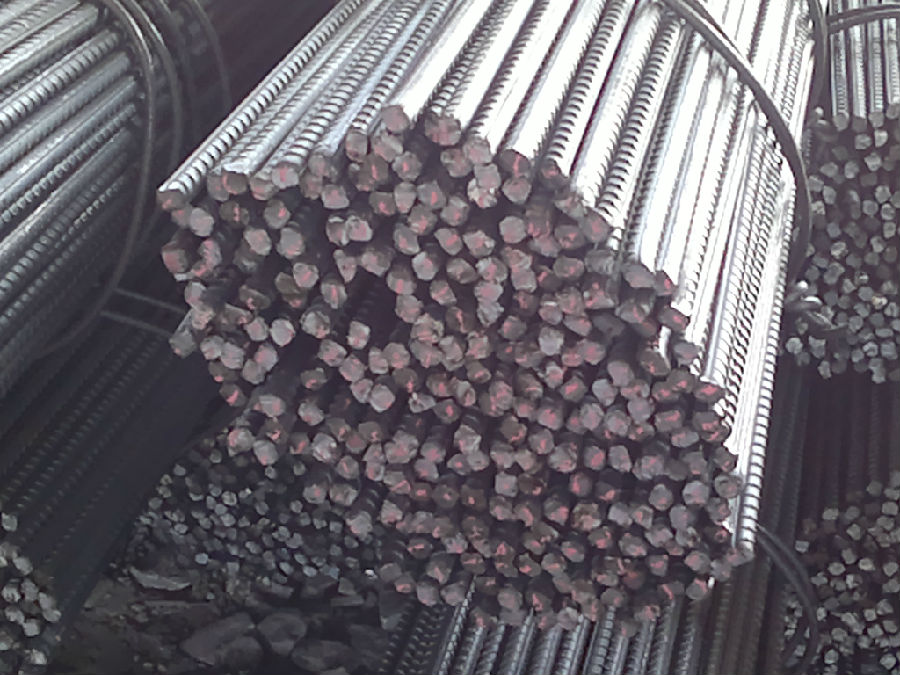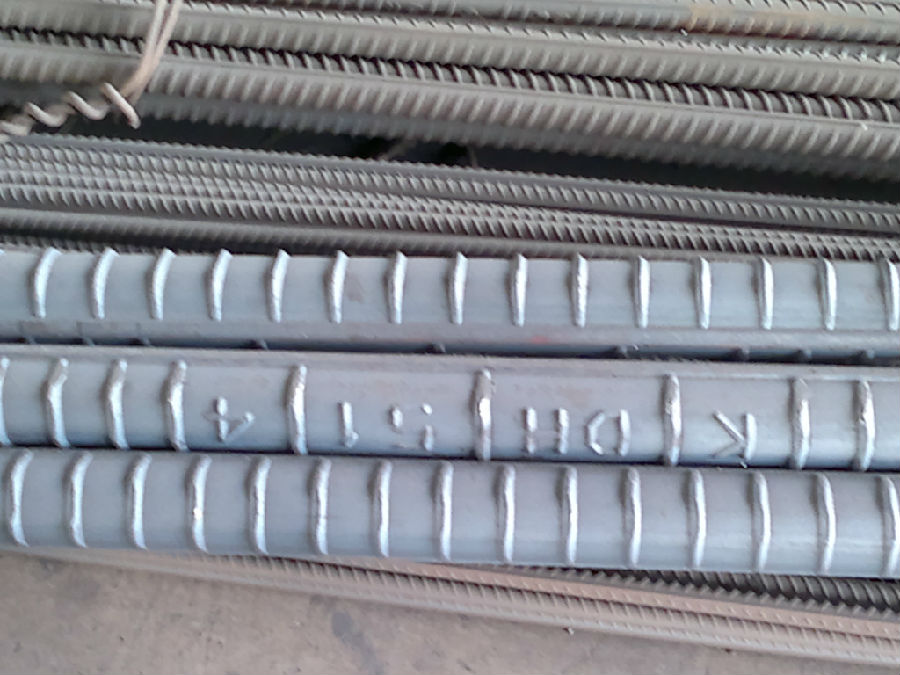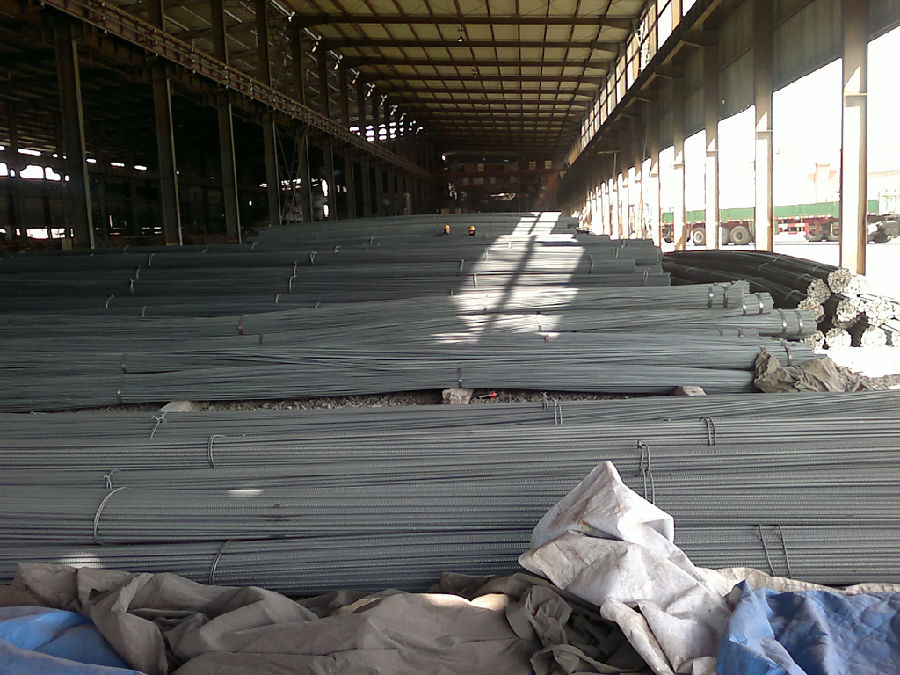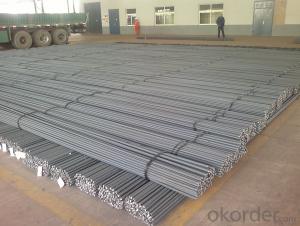Steel Rebar/Deformed Steel Bar / Iron Rods for Construction/Concrete
- Loading Port:
- Tianjin
- Payment Terms:
- TT or LC
- Min Order Qty:
- 100 m.t.
- Supply Capability:
- 30000 m.t./month
OKorder Service Pledge
OKorder Financial Service
You Might Also Like
OKorder is offering Steel Rebar/Deformed Steel Bar / Iron Rods for Construction/Concrete at great prices with worldwide shipping. Our supplier is a world-class manufacturer of steel, with our products utilized the world over. OKorder annually supplies products to African, South American and Asian markets. We provide quotations within 24 hours of receiving an inquiry and guarantee competitive prices.
Product Applications:
Steel Rebar/Deformed Steel Bar / Iron Rods for Construction/Concrete are ideal for structural applications and are widely usedthe construction of buildings and bridges, and the manufacturing, petrochemical, and transportation industries
Product Advantages:
OKorder's Steel Rebar/Deformed Steel Bar / Iron Rods for Construction/Concrete are durable, strong, and wide variety of sizes.
Main Product Features:
· Premium quality
· Prompt delivery & seaworthy packing (30 days after receiving deposit)
· Can be recycled and reused
· Mill test certification
· Professional Service
· Competitive pricing
Product Specifications:
Manufacture: Hot rolled
Grade:HRB400
Certificates: ISO, SGS, BV, CIQ
Packed: prproduct packed in bundles
Deformed Steel Bar | ||
Diameter (MM) | Cross Sectional Area (MM2) | Theorectical Weight (KG/M) |
6 | 28.27 | 0.222 |
8 | 50.27 | 0.395 |
10 | 78.54 | 0.617 |
12 | 113.1 | 0.888 |
14 | 153.9 | 1.21 |
16 | 201.1 | 1.58 |
18 | 254.5 | 2 |
20 | 314.2 | 2.47 |
22 | 380.1 | 2.98 |
25 | 490.9 | 3.85 |
28 | 615.8 | 4.83 |
32 | 804.2 | 6.31 |
36 | 1018 | 7.99 |
40 | 1257 | 9.87 |
Grade | Technical data of the original chemical composition (%) | |||||||
C | Mn | Si | S | P | V | |||
HRB400 | ≤0.25 | ≤1.60 | ≤0.80 | ≤0.045 | ≤0.045 | 0.04-0.12 | ||
Physics capability | ||||||||
Yield Strength(N/cm2) | Tensile Strength(N/cm2) | Elongation (%) | ||||||
≥400 | ≥570 | ≥14 | ||||||
FAQ:
Q1: Why buy Materials & Equipment from OKorder.com?
A1: All products offered byOKorder.com are carefully selected from China's most reliable manufacturing enterprises. Through its ISO certifications, OKorder.com adheres to the highest standards and a commitment to supply chain safety and customer satisfaction.
Q2: How do we guarantee the quality of our products?
A2: We have established an advanced quality management system which conducts strict quality tests at every step, from raw materials to the final product. At the same time, we provide extensive follow-up service assurances as required.
Q3: How soon can we receive the product after purchase?
A3: Within three days of placing an order, we will arrange production. The normal sizes with the normal grade can be produced within one month. The specific shipping date is dependent upon international and government factors, the delivery to international main port about 45-60days.
Q4: How many tons of steel products could be loaded in containers?
A4: Usually the steel products are delivered by bulk vessel because of the large quantity and the freight. However, there are no bulk vessel enter some seaports so that we have to deliver the cargo by containers. The 6m steel product can be loaded in 20FT container, but the quantity is changed according to the size, usually from 18tons to 25tons.
Images:



- Q:What is the effect of moisture on steel rebars?
- The effect of moisture on steel rebars can lead to corrosion, which weakens the rebars and reduces their structural integrity over time. Moisture can initiate the oxidation process, causing the rebars to rust and potentially compromise the stability of reinforced concrete structures. Regular inspection and maintenance are crucial to prevent and address any moisture-related damage to steel rebars.
- Q:What are the different types of coatings available for steel rebars?
- There are several types of coatings available for steel rebars, including epoxy coatings, galvanized coatings, and polymer coatings. Epoxy coatings are commonly used to provide corrosion protection and improve bond strength. Galvanized coatings involve applying a layer of zinc to the rebar's surface, offering excellent corrosion resistance. Polymer coatings are also used to protect against corrosion and enhance durability, often including additives like epoxies, polyurethanes, or polyethylene.
- Q:How do steel rebars affect the overall fire safety of concrete structures?
- Steel rebars can have both positive and negative effects on the overall fire safety of concrete structures. On one hand, steel rebars can help enhance the fire resistance of concrete structures. Concrete has a relatively low thermal conductivity, which means it does not conduct heat easily. However, when exposed to fire, concrete can crack and lose its structural integrity. The presence of steel rebars helps to mitigate this issue by providing additional tensile strength to the concrete. The rebars act as reinforcement, helping to prevent the concrete from cracking and collapsing under the intense heat of a fire. On the other hand, steel rebars can also pose some challenges to the fire safety of concrete structures. Steel is a good conductor of heat, which means that it can transfer heat from the fire to other parts of the structure. This can potentially lead to the weakening of the concrete and compromise the overall fire safety. Additionally, steel rebars can expand when exposed to high temperatures, which may cause further cracking and damage to the concrete. To address these challenges, various measures can be taken to improve the fire safety of concrete structures with steel rebars. The use of fire-resistant coatings or fireproofing materials on the rebars can help to minimize the heat transfer from the steel to the surrounding concrete. Fire-resistant insulation or fire barriers can also be installed around the rebars to further protect the concrete from the heat of a fire. Additionally, proper design and construction practices, including the appropriate spacing and size of rebars, can help to ensure that the concrete structure maintains its fire resistance. In conclusion, steel rebars play a crucial role in the fire safety of concrete structures. While they can enhance the fire resistance of concrete, they can also present challenges such as heat transfer and expansion. By implementing appropriate measures and construction practices, the negative effects of steel rebars on fire safety can be minimized, and the overall fire resistance of concrete structures can be improved.
- Q:How do steel rebars enhance the structural integrity of a building?
- Steel rebars enhance the structural integrity of a building by providing reinforcement and strength to concrete structures. They prevent cracking, bending, and collapsing under heavy loads, seismic activities, and temperature changes, ensuring the stability and durability of the building.
- Q:Can steel rebars be used in structures with aggressive chemical exposure?
- Steel rebars can be used in structures with aggressive chemical exposure, but their performance may be compromised depending on the specific chemicals involved. It is crucial to select the appropriate type of steel with corrosion-resistant properties or use protective coatings to prevent degradation and maintain structural integrity. Additionally, regular maintenance and monitoring are required to ensure the rebars' durability in such environments.
- Q:Can steel rebars be used in structures with high alkaline environments?
- Steel rebars can generally be used in structures with high alkaline environments, such as those found in concrete. However, it is important to consider the potential for corrosion in such environments. The alkaline environment of concrete can provide a protective layer, known as a passive film, on the surface of the steel rebar. This film helps prevent corrosion by minimizing the contact between the steel and the corrosive elements in the environment. However, there are certain factors that can affect the corrosion resistance of steel rebars in high alkaline environments. These include the quality of the concrete, the presence of chloride ions (which can disrupt the passive film), the level of environmental exposure, and the design of the structure. It is crucial to ensure that the concrete used is of high quality, with appropriate measures taken to minimize the presence of contaminants that may accelerate corrosion. In cases where the alkaline environment is extremely aggressive or the structure is exposed to severe conditions, additional protective measures may be necessary. These can include the use of corrosion-resistant coatings or the application of cathodic protection systems to mitigate the risk of corrosion. Overall, while steel rebars can be used in structures with high alkaline environments, it is important to carefully consider the specific conditions and take appropriate measures to ensure the durability and longevity of the structure. Consulting with structural engineers and corrosion specialists can help determine the most suitable approach for using steel rebars in such environments.
- Q:How do steel rebars contribute to sustainable construction?
- Steel rebars contribute to sustainable construction in several ways. First, they have a high tensile strength, which allows for the construction of structurally sound buildings that require fewer materials. This reduces the overall carbon footprint and resource consumption. Second, steel rebars are highly durable and resistant to corrosion, ensuring the longevity of the structure and reducing the need for frequent repairs or replacements. Third, steel is a highly recyclable material, and using rebars made from recycled steel helps reduce the demand for virgin resources and minimizes waste. Overall, steel rebars contribute to sustainable construction by promoting resource efficiency, durability, and recyclability.
- Q:What are the different methods of reinforcing concrete with steel rebars?
- There are several methods commonly used for reinforcing concrete with steel rebars. These methods are designed to enhance the strength and durability of the concrete structure, preventing cracking and failure under various loads and environmental conditions. Here are some of the different methods used: 1. Traditional Reinforcement: This method involves placing steel rebars in a grid pattern within the concrete formwork before pouring the concrete. The rebars are typically arranged in both horizontal and vertical directions, forming a network of reinforcement throughout the structure. This technique is commonly used in buildings, bridges, and other large-scale concrete structures. 2. Post-Tensioning: Post-tensioning is a technique used in large-scale structures where high tensile strength is required. In this method, steel rebars are tensioned after the concrete has been poured and hardened. The rebars are placed in ducts or sleeves within the concrete and then tensioned using hydraulic jacks. This process helps to reduce the tensile stresses within the concrete, making it more resistant to cracking and improving its load-bearing capacity. 3. Pre-Tensioning: Pre-tensioning is a similar technique to post-tensioning, but the tensioning of the steel rebars is done before the concrete is poured. The rebars are typically placed in a precast concrete form, and then tensioned using hydraulic jacks. After the concrete has hardened, the tensioned rebars transfer their force to the concrete, increasing its strength and reducing the risk of cracking. 4. Welded Wire Mesh: Welded wire mesh is a method of reinforcing concrete that involves using a grid of welded steel wires instead of individual rebars. The mesh is typically made of high-strength steel wires, welded together at intersections. This method is commonly used in smaller concrete structures, such as sidewalks, driveways, and patios. Welded wire mesh provides a uniform reinforcement throughout the concrete, reducing the risk of cracking. 5. Fiber Reinforced Concrete: Fiber reinforced concrete (FRC) is a method of reinforcement that involves adding small, discrete fibers to the concrete mix. These fibers can be made of various materials, such as steel, glass, or synthetic polymers. The fibers are distributed throughout the concrete mix, enhancing its tensile strength and reducing cracking. FRC is commonly used in applications where traditional steel rebars are not feasible, such as thin slabs, precast elements, or shotcrete. Overall, these different methods of reinforcing concrete with steel rebars provide engineers and construction professionals with various options to enhance the strength, durability, and performance of concrete structures. The choice of method depends on factors such as the size and type of the structure, the required strength, and the construction constraints. It is essential to consider these factors and consult with engineering professionals to determine the most suitable method for each specific project.
- Q:Can steel rebars be painted or coated?
- Yes, steel rebars can be painted or coated. Painting or coating steel rebars helps to protect them from corrosion and extend their lifespan. It is a common practice in construction and reinforcement projects to apply paint or protective coatings on steel rebars to enhance their durability and resistance to environmental factors.
- Q:What is the difference between three - grade steel and two - grade steel?
- Two grade steel thread subway project a little more, three grade steel room building project a little more. In addition, the original use of two steel more, and now are promoting the new three grade steel, concrete structure among the application has been very common. Three grade thread steel used in beam column main reinforcement is more, two grade thread steel used in more stirrups, recently, the state also issued expressly eliminated HRB335 two grade steel and HPB235 high wire.
1. Manufacturer Overview |
|
|---|---|
| Location | |
| Year Established | |
| Annual Output Value | |
| Main Markets | |
| Company Certifications | |
2. Manufacturer Certificates |
|
|---|---|
| a) Certification Name | |
| Range | |
| Reference | |
| Validity Period | |
3. Manufacturer Capability |
|
|---|---|
| a)Trade Capacity | |
| Nearest Port | |
| Export Percentage | |
| No.of Employees in Trade Department | |
| Language Spoken: | |
| b)Factory Information | |
| Factory Size: | |
| No. of Production Lines | |
| Contract Manufacturing | |
| Product Price Range | |
Send your message to us
Steel Rebar/Deformed Steel Bar / Iron Rods for Construction/Concrete
- Loading Port:
- Tianjin
- Payment Terms:
- TT or LC
- Min Order Qty:
- 100 m.t.
- Supply Capability:
- 30000 m.t./month
OKorder Service Pledge
OKorder Financial Service
Similar products
New products
Hot products
Related keywords




























